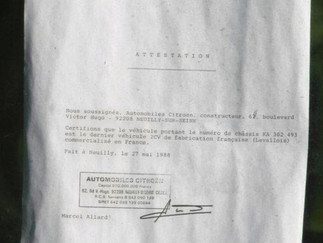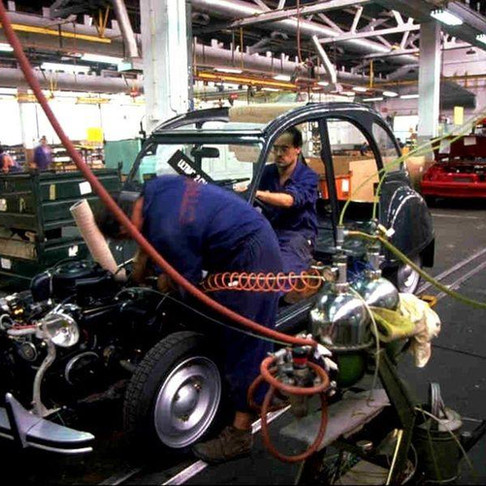CITROËN: The latest 2CVs
- COCKPIT

- Mar 26
- 4 min read
The Citroën 2CV is one of the quintessential icons of the French car. It has had a turbulent history, both in its early days and at the end of its production run. Affordable, durable, compact, and easy to maintain, the 2CV, as it's known, represented the democratization of the gasoline-powered car and, for 40 years, the French art of living.
Its history began after Michelin's acquisition of Citroën in 1935. The upper management of the Chevron brand clearly wanted to target the economy car market. This is why Pierre-Jules Boulanger, newly appointed CEO of Citroën, was tasked with bringing this project to fruition.
The market research for this project revealed the expectations of potential customers. It was with this that Boulanger developed precise specifications for what would be called the TPV (Toute Petite Voiture) before the war, which was based on a fairly simple concept: "Four wheels under an umbrella", with four seats, 50kg of transportable luggage, 2CV tax, front-wheel drive, 3-speed gearbox, solid suspension, allowing you to cross a ploughed field with a new basket without breaking a single one, and a top speed of 60km/h.

The first projects resulted in a car made of very thin corrugated iron. But it was a debacle for Citroën, which had to dismantle all the "Project A" models already assembled. War came to France, and the Nazis, aware of the TPV project, tried to acquire the plans for their "Volkswagen." Boulanger fiercely opposed this and never disclosed them. The TPV projects continued in secret even in 1941 after the bombing of the Quai de Javel factory. At the end of the war, the pace of research accelerated, and Citroën succeeded in developing a new engine.
"There was pressure all over Europe for an economical car, intended for the average person. Fiat, for example, created its famous Topolino in 1936, and, above all, Ferdinand Porsche's Beetle, from Volkswagen—the "people's car" the Nazis dreamed of. »
— Éric Dussault
In 1948, Citroën presented a near-final project, the "2CV Type A." It received a rather mixed reception and was harshly criticized by the press, which described it as a sardine can. Despite this, its impact on the public was significant due to its low price.
In 1949, after being designated "Type A" by the Mines Department, production of the 2CV Type A began.
In 1951, a utility version of the Type A was presented, the 2CV Type AU. It could carry 150 kg of goods and two people.
However, the model suffered from its lack of youthfulness in the mid-1980s. It was also shunned by certain countries with very strict regulations (particularly regarding pollution and safety).
Forty years later, production ended in France.
The last 2CV manufactured and sold in France
This cormorant gray 2CV 6 Spécial left the Citroën factory in Levallois-Perret on May 18, 1988. Since then, parked in a garage in Orne, the car was stolen between January 19 and March 13. It was found burned out on Thursday in the neighboring department of Eure. "As early as 1974, Roger Brioult, who was editor-in-chief of the Revue technique automobile, understood that this car was becoming a legend. He had already ordered the last 2CV," Alan Blondeau, who was in charge of Roger Brioult's vehicles, told Ouest-France.
When Citroën objected that 2CV production wouldn't stop immediately, the collector reportedly replied: "I don't care, I'll pay for it now!"
Upon leaving the production line, the collector car was delivered to its buyer in Résenlieu (Orne), also the author of numerous books devoted to automotive history. Delivery was made by flatbed truck. The final 2CV was then pushed by hand to the collector's garage: it had never left its box. And the vehicle had never been registered.
The owner was out of the question to start the engine! The odometer reading was only 5 kilometers: a distance corresponding to the usual factory tests conducted for each car. A copy of the Citroën certificate authenticating the last 2CV produced in France was affixed to a window. Has this antique, valued at €110,000, attracted the attention of an unscrupulous enthusiast? Between January 19 and March 13, the 2CV was stolen. The 90-year-old owner, already weakened, died on March 24. The theft had left him stunned, according to a relative. News of the theft circulated through car clubs and among collectors. "This 2CV was too well-known and unsaleable," said one expert. The discovery of the burnt-out vehicle leaves open theories about the perpetrators of the theft.
However, the story of this 2CV is not over, since its wreck will be sold at auction in March 2013 for €10,800.
The 2CV will continue its career for another 2 years elsewhere in the world.
The last of the deuches is Portuguese
Indeed, its production began in 1948 in France and ended definitively 42 years later, in 1990, in Mangualde, Portugal.
Thus, on July 27, 1990, 2CV production reached its final day. At 4:30 p.m., 2CV No. 5,114,961 arrived at the end of the production line. It was a gray 2CV Charleston; it would be the last 2CV.
At the end of its production run, the 2CV was offered in two versions: the Special, which was the most economical, and the more elegant Charleston, featuring the two-tone paint scheme of the eponymous special edition released in 1980.
The production cycle was filmed, and a fanfare accompanied its departure from the factory—a rather meager celebration for the departure of a legendary car, and the most produced Citroën.
This car was acquired by the director of the Mangualde factory, before it was bought by the Citroën Conservatory.
Production years: 1948-1990
Maximum horsepower: SAE 9 to 29 hp
Production: 5,114,961 units
Length: 3.83 meters
Width: 1.48 meters
Height: 1.60 meters























Comments